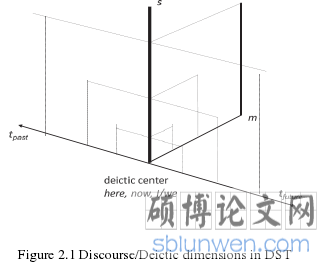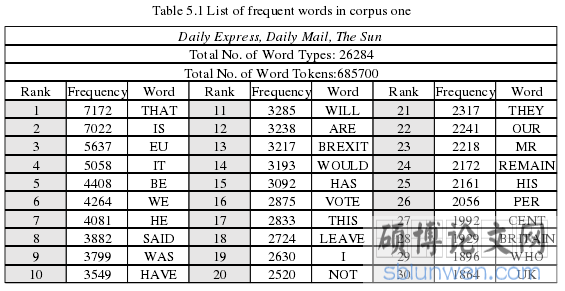笔者借鉴话语空间理论和近义化理论中的STA近义化模型,重点分析英国报纸上的脱欧话语如何以及为什么倾向于其他欧盟国家,并将欧盟和移民描述为对英国及其人民的巨大威胁。
Chapter 1 Introduction
1.1 Research Background
1.1.1 Brexit and the EU Referendum
On June 23, 2016, the United Kingdom voted for Brexit-withdrawal from the European Union (E.U.) in the EU referendum, i.e., its national referendum on EU membership. There was a sense of shock and disbelief both in Britain and across European capitals, when it turned out that a small majority (51.9 percent) of British voters cast their ballot in favor of leaving the EU. Brexit was not the result expected, or campaigned for, by the major political parties in Britain, including the main opposition party, Labour. The major business interests and trade unions are on the remain side, as well as most foreign leaders and international organizations (Hobolt, 2016, p. 1261).
However, the outcome of the referendum on EU membership was not surprising to some extent (Hobolt, 2016, pp.1260-61). Among the various reasons behind the vote to leave, two facts are not to be ignored. First, ever since the UK joined the European Economic Community (EEC) in 1973, the British public has consistently been the most Eurosceptic electorate, and opinion polls conducted before the referendum had suggested that the Brexit referendum would be a very close race. Second, public worries about economic recession, and anger with the major parties’ inability to manage immigration issue properly have contributed to the electoral successes of populist parties in Britain and across Europe, and the anti-establishment message has made the leave campaign highly effective (Hobolt & Tilley, 2016; Kriesi, et al., 2012).
.........................
1.2 Research Questions
From the perspective of threat construction, this thesis offers a corpus-based critical discourse analysis of language immediately surrounding the terms “Brexit” and “immigration” in the news coverage by three British tabloids (the Daily Express, the Daily Mail, and the Sun) between June 2015 and June 2016. Drawing upon Discourse Space Theory (DST) and Proximization Theory (PT), the current research intends to answer the following three questions:
1)How does Brexit newspaper discourse construct antagonism between us (Britain) and them (the EU) and depict the EU as a threat to the British economy, political/legal sovereignty, and immigration control?
2)How is immigration depicted as an approaching threat and What are the key lexico-grammatical items which are applied to depict the external threat of immigration?
3) Why are the EU and immigration constructed as a threat in Brexit newspaper discourse?
.......................
Chapter 2 Literature Review
2.1 Previous CDA Research
2.1.1 CDA in General
Critical Discourse Analysis(CDA)is a type of discourse analytical research that primarily studies the way social power abuse, dominance, and inequality are enacted, reproduced, and resisted by text and talk in social and political contexts (van Dijk, 2001, p.352). In CDA research, language is thought to be the tool of creating society, and critical discourse analysts commonly recognize that there exists a process of lexico-grammatical selection when people are conveying messages via language. The selection, being subconscious or with purpose, is subject to the dominance of certain rules, and it features, at a certain level, systematicity (Fowler, Hodge, Kress, & Trew, 1979, p.188). In light of this, the social analysis came to be the main and critical part of discourse analysis while the language analysis became a means of conducting the social analysis.
2.1.2 CDA, Political Discourse, and Newspapers
As a combination of contemporary linguistics and social science, CDA research of political discourse has developed to be one of the most dynamic research fields. It covers a wide range of themes, including education, diplomacy, economics, healthcare, environment, and immigration, and the forms of the texts range from speech, debate, interviews, editorials to press conference and newspapers.
............................
2.2 Corpus Linguistics and CDA
2.2.1 Synergy of Corpus Linguistics and CDA
The linguistic system was inherently probabilistic (Halliday, 1991, p.31). That is to say, the probabilistic information in language constitutes an important part of the nature of language. Corpus linguists have been focused on analyzing and processing language data from different perspectives to get the probabilistic information of meaning in the texts. CL converges with CDA on the importance of meaning while they differ greatly in terms of research methods. CL features quantitative data while qualitative analysis is often thought to be lying at the heart of CDA. CL, however, can still make a good match of CDA since the latter has been put under much criticism about its lack of representativeness of language data and of the objective and systematic analysis of those data. Since Hardt-Mautner, Stubbs strengthened CDA with Corpus Linguistics, scholars in this field have made some efforts to implement the corpus methodology to CDA, while there are lots of research possibilities to be explored.
2.2.2 Corpus Linguistics and Political Discourse in Media
The recent 20 years have seen more researches that applied Corpus Linguistics methodologies to CDA. These researches explore the internal meaning of discourse through the observation of word frequencies, concordance lines, keywords, collocations, word clusters, lexical patterns, and grammatical structures.

..............................
Chapter 3 Analytical Framework ......................... 18
Chapter 4 Methodology .................... 20
4.1 Data Collection and Corpus Building ....................... 20
4.2 Data Processing ..................................... 21
Chapter 5 Analysis and Discussion ............................... 26
5.1 Threat Construction in Brexit Newspaper Discourse ..................... 26
5.1.1 Conceptualization of us (Britain) and them (E.U.) ............................... 30
5.1.2 Economic Threat ........................... 32
Chapter 5 Analysis and Discussion
5.1 Threat Construction in Brexit Newspaper Discourse
With the help of corpus software, Section 5.1 analyzes the news texts on Brexit by 3 pro-Leave tabloids, utilizing the means of word frequency, collocation, and concordance in order.
Word frequency is the most basic statistical method in corpus linguistics. It implements the analysis of texts from the most basic lexical level. With the help of this method, researchers can intuitively obtain the salient features of the specific language. The use of high-frequency words can largely reflect the author's attitude and consciousness. After omitting common articles, prepositions, and conjunctions, I sorted out the top 100 highly frequent words in corpus one. Below is the list of top 30 frequent words. It can be seen from the list that the marked words of us entities, i.e., “we” (4264), “I” (2630), “our” (2241), “Britain” (1929), and “UK” (1864) and them entities, i.e., “EU” (5637) and “they” (2317) appear very frequently, which conforms to the rule of dichotomy as specified in DST. Besides these words, other deictic words on the high-frequency word list include “us” (1148) and “British” (1001) of us camp,and “their”(1483), “European” (1264), “Europe” (1065), “immigration”(963), and “Brussels” (766) of them camp. Also, it can be seen from the list that words concerning the salient issues in the Brexit campaign also appear frequently, including “immigration” (963), “economy” (733), and “market” (617).

..........................
Chapter 6 Conclusion
6.1 Major Findings
This thesis conducts a corpus-based CDA research of news coverage on Brexit and immigration published in the previous year of the EU referendum. Drawing on Discourse Space Theory and STA proximization model in Proximization Theory, it focuses on how and why Brexit discourse in British newspapers tend to other the EU and depict the EU and immigration as a great threat encroaching upon Britain and its people. The main findings of this thesis include:
1) Brexit newspaper discourses tend to construct an antagonism between us and them and depict the EU as a threat to the British economy, political/legal sovereignty, and immigration control. The us camp (Britain) is consolidated through the repetitive reference to the shared values such as “courage”, “democracy”, which constitutes the prerequisite to oppose and resist the threat and damage inflicted by them camp (the EU). In contrast, them is othered through being referred to as “faceless”, “undemocratic”, etc., and thus construed as socio-politically and ideologically alien and potentially antagonistic to us party. The EU and EU membership are negatively represented as causing the “sovereignty loss” of Britain. EU membership cost is argued as a great burden on the British economy, threatening to deplete public spending, such as NHS, schools, and housing. EU is condemned for overruling the British legal system, threatening national security and sovereignty control. Besides, the EU is depicted as both a source of European migrants and a conduit through which illegal migrants and refugees flood into Britain, threatening public security and safety as well as national prosperity.
reference(omitted)
